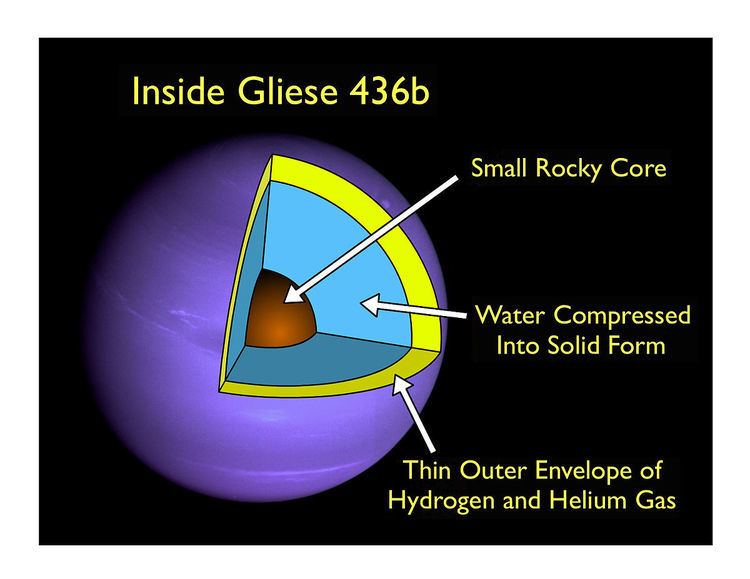[Fe/H] -0.32 Discovery site California, USA | Discovery date August 31, 2004 Discovery status Published | |
 | ||
Gliese 436 b /ˈɡliːzə/ (sometimes called GJ 436 b) is a Neptune-sized exoplanet orbiting the red dwarf Gliese 436. It was the first hot Neptune discovered with certainty (in 2007) and was among the smallest-known transiting planets in mass and radius, until the much smaller Kepler exoplanet discoveries started coming in by 2010.
Contents
In December 2013, NASA reported that clouds may have been detected in the atmosphere of GJ 436 b.
Discovery
Gliese 436 b was discovered in August 2004 by R. Paul Butler and Geoffrey Marcy of the Carnegie Institute of Washington and University of California, Berkeley, respectively, using the radial velocity method. Together with 55 Cancri e, it was then the first of a new class of planets with a minimum mass (M sini) similar to Neptune.
The planet was recorded to transit its star by an automatic process at NMSU on January 11, 2005, but this event went unheeded at the time. In 2007, Gillon led a team which observed the transit, grazing the stellar disc relative to Earth. Transit observations led to the determination of Gliese 436 b's exact mass and radius, both of which are very similar to Neptune. Gliese 436 b then became the smallest-known transiting extrasolar planet. The planet is about 4,000 km larger in diameter than Uranus and 5,000 km larger than Neptune and a bit more massive. Gliese 436b (also known as GJ 436b) orbits its star at a distance of 4,000,000 km or 15 times closer than Mercury's average distance from the Sun.
Physical characteristics
The planet's surface temperature is estimated from measurements taken as it passes behind the star to be 712 K (439 °C; 822 °F). This temperature is significantly higher than would be expected if the planet were only heated by radiation from its star (which had been, in a Reuters article from a month prior to this measurement, estimated at 520 K). Whatever energy tidal effects deliver to the planet, it does not affect its temperature significantly. A greenhouse effect could raise the temperature to much higher degrees than the predicted 520–620 K.
Its main constituent was initially predicted to be hot "ice" in various exotic high-pressure forms, which would remain solid despite the high temperatures, because of the planet's gravity. The planet could have formed further from its current position, as a gas giant, and migrated inwards with the other gas giants. As it arrived in range, the star would have blown off the planet's hydrogen layer via coronal mass ejection.
However, when the radius became better known, ice alone was not enough to account for it. An outer layer of hydrogen and helium up to ten percent in mass would be needed on top of the ice to account for the observed planetary radius. This obviates the need for an ice core. Alternatively, the planet may be a super-earth.
Observations of the planet's brightness temperature with the Spitzer Space Telescope suggest a possible thermochemical disequilibrium in the atmosphere of this exoplanet. Results published in Nature suggest that Gliese 436b's dayside atmosphere is abundant in CO and deficient in methane (CH4) by a factor of ~7,000. This result is unexpected because, based on current models at this temperature, the atmospheric carbon should prefer CH4 over CO.
In June 2015, scientists reported that the atmosphere of Gliese 436 b was evaporating, resulting in a giant cloud around the planet and, due to radiation from the host star, a long trailing tail 14×10^6 km (9×10^6 mi) long.
Orbital characteristics
One orbit around the star takes only about 2 days, 15.5 hours. Gliese 436 b's orbit is likely misaligned with its star's rotation.
The eccentricity of Gliese 436 b's orbit is inconsistent with models of planetary system evolution. To have maintained its eccentricity over time requires that it be accompanied by another planet.
